A while back, I wrote about Sir Oliver, a parrot that performed on Broadway in the early 1900s and served as mascot for The Lambs, America’s first professional theatrical club.
Right after I posted the story, New York actor and Lambs’ Shepherd (president) Marc Baron contacted me to tell me that The Lambs also had a mascot tomcat named Tommy in the 1930s. He sent me a picture of Tommy that is on display at the club’s current headquarters, and I began to do some research.
As I searched for more information on Tommy, I came across two articles in The Sunday Telegraph and The New York Times about Billy, a goat that was also a Lambs’ mascot in the early 1900s (you’d think actors could come up with more original mascot names!). Although the details differ slightly in both articles, the most likely story is that Billy came to The Lambs via honorary member Daniel Frohman sometime around January 1902.
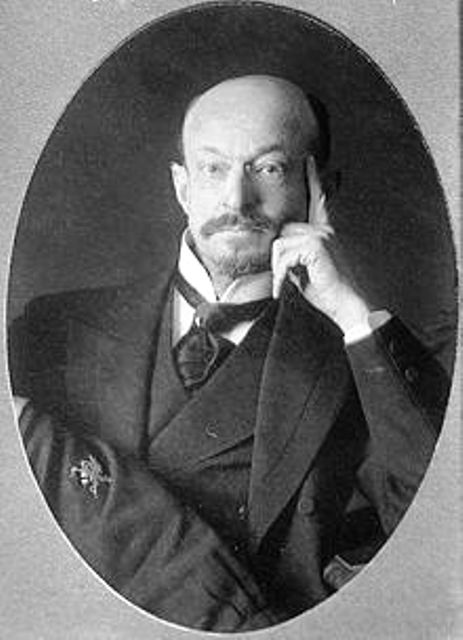
Daniel Frohman, an honorary member of The Lambs, was the producer-manager of the Lyceum Theatre and the Lyceum Theatre Stock Company from 1886 to 1909.
According to the report in the Telegraph, Daniel Frohman had gone to Harlem in search of a goat for Miss Hilda Spong, who was performing with Frohman’s Lyceum Theatre Stock Company. Miss Spong was playing the role of Esmeralda in “Notre Dame” at Daly’s Theatre on Broadway, and she needed a goat to play the role of Djali.
Daniel returned from his jaunt with Billy, a white goat that, until that point, had been surviving on garbage in the wild lands of Harlem Heights.
From February 26 to April 6, 1902, Billy appeared on stage every night as the clever goat with gold-painted hoofs and horns (as depicted by Victor Hugo in his 1831 novel The Hunchback of Notre Dame).
When he wasn’t performing, Billy made his home at the Lambs Club on West 36th Street in the Herald Square Theater District, where he was treated like royalty with weekly baths and grooming.

The Daly Theatre at 1221 Broadway opened in 1867 as Barnvard’s Museum, a museum-theater operated by owner John Banvard. In 1879, Augustin Daly took over, creating one of America’s foremost theaters. After his death in 1899, various managers followed, including the Shuberts. It was operating as a burlesque house when it was demolished in 1920.
In a preview of “Notre Dame” in the January 1902 issue of “The Theatre,” most of the performers were panned, but Billy received a thumbs-up:
“With the exception of Esmeralda’s goat, the only natural-appearing, convincing creatures on the stage are Mr. (George) Barbier’s Quasimodo, Mr. (James Lee) Finney’s Gringoire, and, in a limited way, Mr. (Frank) Bangs’ Major Galiache.”
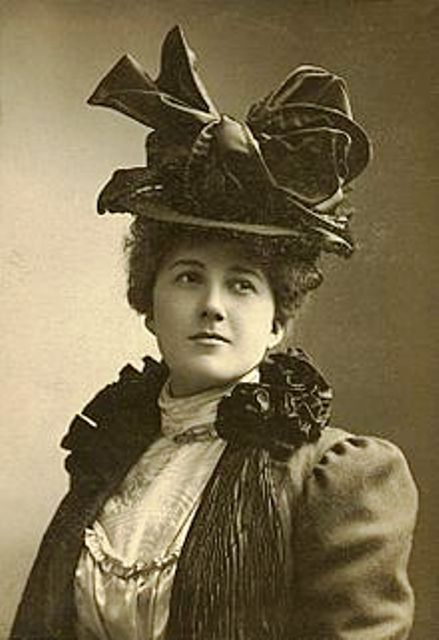
Hilda Spong did not receive any rave reviews for her betrayal of Esmeralda in “Notre Dame.” But her “leading man,” Billy the goat, did win over the critics with his strong will to take center stage.
Billy also received some ink in The New York Times’ review of the play on February 27, the day after opening night:
“Esmeralda’s goat made his entrance in the first act, and showed a strong histrionic instinct! At least, when one of the stage people tried to lead him out of the centre of the stage he resisted stoutly.”
Although Billy spent most of his time in The Lambs’ back yard at 70 West 36th Street, he preferred being indoors where there many more items other than a wood fence to chew on and destroy. Billy was particularly fond of towels, hats, slippers, and umbrellas. He was always blamed when items disappeared – he even took the blame one time when a diamond ring went missing from the club.
1932: Tommy Joins The Lambs Flock
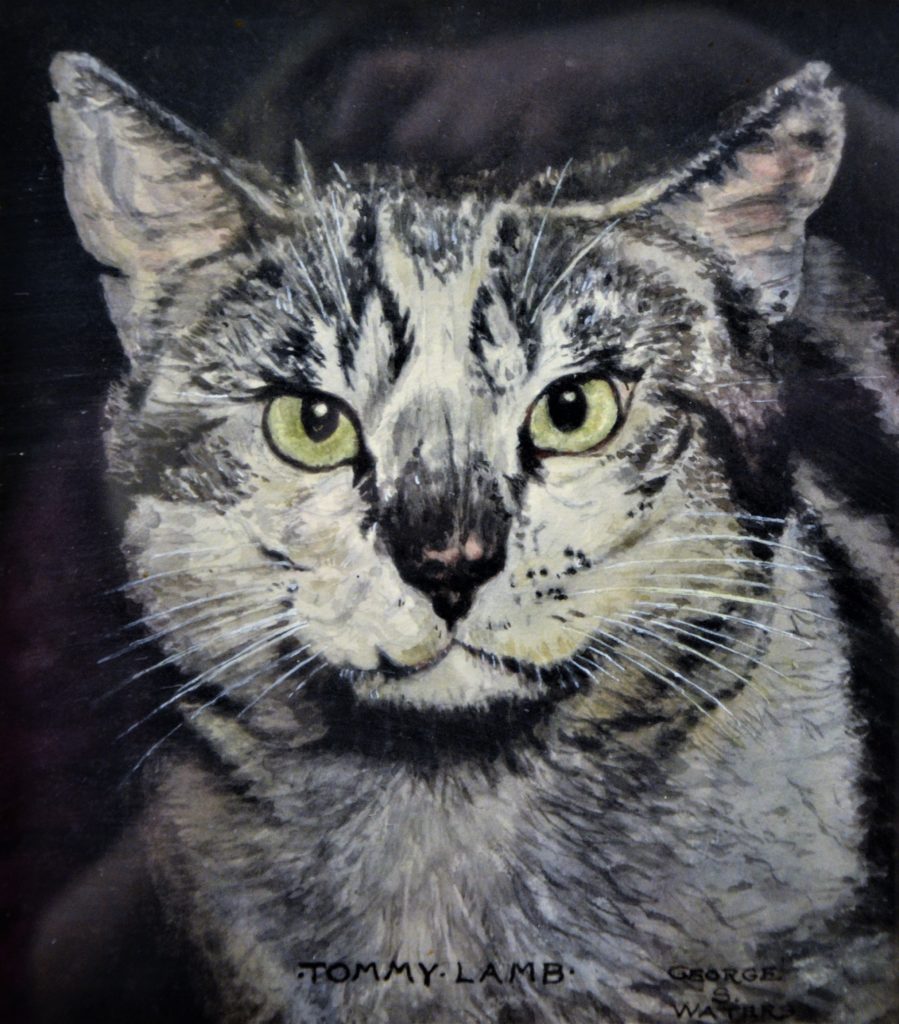
Tommy Casanova Lamb is a life member of The Lambs. To this day, his picture hangs in their clubhouse on West 51st Street. Photo courtesy of The Lambs Collection.
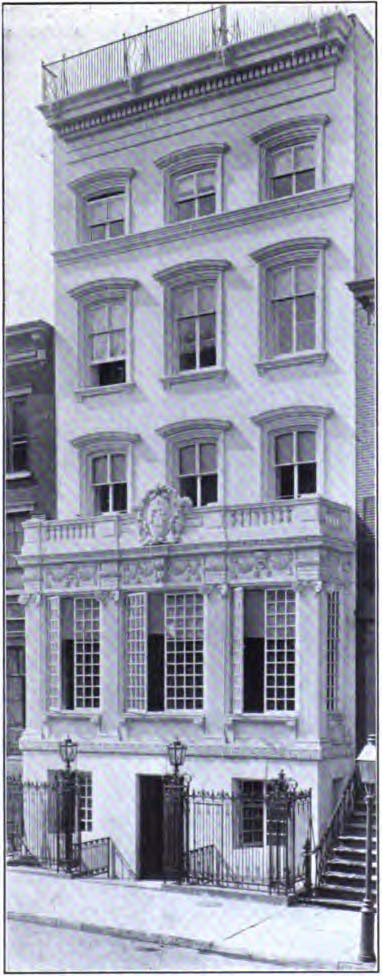
The Lambs moved to West 36th Street in 1897 and stayed there until 1905. It was here that Shepherd Clay M. Greene inducted Billy the goat as their mascot.
Tommy C. Lamb…was truly a remarkable cat. Merely an alley cat when he first came to the Lambs, he blossomed forth as one of the most beautiful cats you have ever seen. There wasn’t a pregnant cat within a radius of six blocks that didn’t blame it on Tom. He really was remarkable.–Joe Laurie, Jr., 1953
Tommy Casanova Lamb, a husky grey-and-white cat from the Hell’s Kitchen neighborhood, wandered into The Lambs Club in 1932 when he was just a kitten. There, at 128 West 44th Street, he took up his station at the bar, where he spent most of his waking hours gazing at the celebrity customers, fattening up on beer and free lunches, or kicking out any other cats that tried to create disorder in the club.
Although The New York Times called Tommy the Feline Bar Fly, he did keep good order at the establishment. One time a black tom with green eyes from Sixth Avenue crashed into the bar and tried to steal some bologna from the counter. As the Times reported, Tommy evicted him with a few well-placed lefts.
Tommy was also a very smart feline. Not only did he know when anyone in the dining room ordered fish, he was quite aware that The Lambs Club was his forever home.
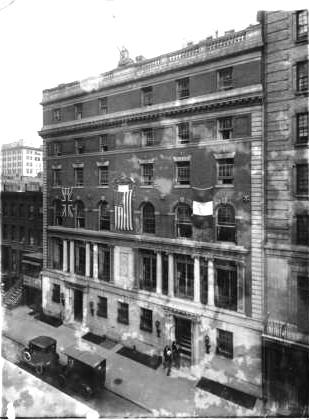
Tommy made his home at The Lambs clubhouse on West 44th Street. This building was designated a New York City Landmark in 1974 and added to the National Register of Historic Places in 1982. Today it is home to the Chatwal Hotel, which operates a restaurant called the Lambs Club.
For example, in December 1935, vaudeville singer and pianist Herb Williams borrowed Tommy for his trick piano skit at a gambol at the Waldorf. During the finale, as the piano fell apart, Tommy popped out, let out a loud meow, jumped over the footlights and ran down the aisle and out the door.
Two hours later, drenched by rain, he appeared at the entrance to The Lambs clubhouse, meowing to be let in.
One of the reasons Tommy may have felt so at home with The Lambs is that, according to club members (tongue in cheek), he was reportedly a descendant of one of the performing cats in Charles Swain’s Rats and Cats vaudeville act.
This act featured rats dressed as jockeys who would ride on the cats’ backs around a little racetrack. The climax of the act was a comedy skit featuring two cats boxing each other.

Herb Williams (Herbert Schussler Billerbeck) had a trick piano that fell apart during his act. In 1935, one year before his death, he borrowed Tommy to jump out of the piano. You can see Tommy running away in this video capture. You can also click here to see and hear the entire act.
Based on Tommy’s track record as a fighter — the Times dubbed him “the toughest cat of New York” — I have a feeling that if he truly was a descendant of one of Swain’s feline performers, it would have been one of the boxing cats.
You see, Tommy had a bad habit of flirting with the other tomcat’s wives, which not only earned him the title “The Great Lover of the Forties,” but also got him into trouble with the competition. Many a boxing match took place when Tommy tried to add another female to his feline harem.
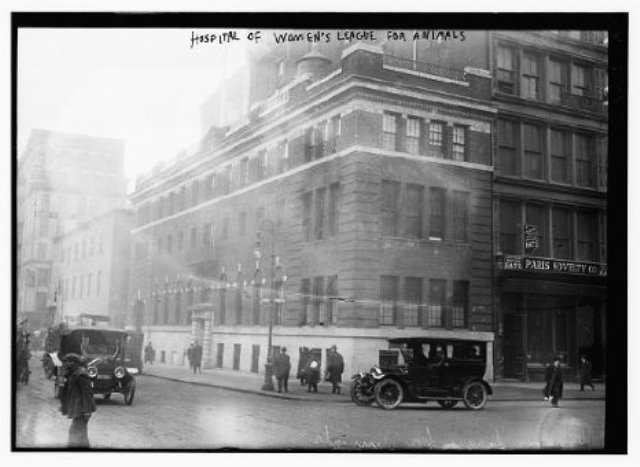
Tommy spent several days healing from his wounds at the Ellin Prince Speyer Hospital for Animals at 350 Lafayette Street (at the cost of $3 a day). Formerly known as the Hospital of Women’s League for Animals, the facility opened in 1914.
One time, Tommy got into a fight with Felix Adelphi, the tuxedo cat mascot of the Alpha Delta Phi Club, which was next door at 136 West 44th Street. Another time, after an all-night battle in the winter of 1936, he limped home in such a shocking state of disrepair that he was put in a taxi cab and rushed to the Ellin Prince Speyer Hospital for Animals.
Dr. James R. Kinney, chief vet, said it was one of the worst cases of mayhem and mussing up that he had ever seen. Although the vet thought Tommy’s wounds would lead to gangrene, the tough cat pulled through, albeit, he had quite a few more battle scars.
Tough Tomcat to Take Girlfriend to Party
To celebrate Tommy’s recovery from the big fight, the Gallery Boys, the younger set of The Lambs Club, decided to hold a testimonial dinner for Tommy Lamb in March 1936. On March 21, the headline in The New York Post read: “Lambs Club’s Tough Tomcat to Take Girlfriend to Party.” Right above this story, the headline was, “Hitler is Asked for Counter-Plan.”
According to the article, Joe Laurie, Jr., super president of the Gallery Boys, came up with the idea for the dinner. The special dinner featured all of Tommy’s favorite dishes, including scallops, stuffed olives, cantaloupe, and beer.Tails and white tie were compulsory, and it was agreed that Tommy would sit at the head of the table (although no one wanted to volunteer to make him sit there.)
Tommy’s latest girlfriend, a little black-and-white kitty who lived at the nearby Central Union Bus Terminal, was invited to be his escort for the evening. The Alpha Delta Phi fraternity asked if Felix could attend, but that request was shot down by the Gallery Boys.
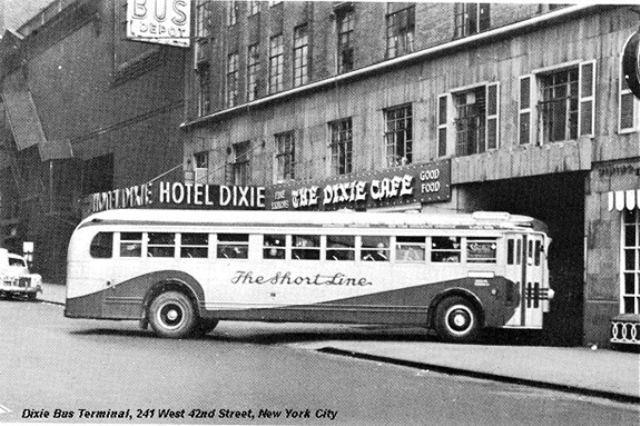
Before the Port Authority Bus Terminal, there was a much smaller Central Union Bus Terminal at the Hotel Dixie on W. 42nd Street. Tommy’s favorite girlfriend was a black-and-white kitty who lived at the terminal. She was also invited to Tommy’s dinner, although I’m not sure if she attended.
Laurie, who wrote about the event in his book Vaudeville from the Honky Tonks to the Palace, reported that everyone wore evening clothes, many great speeches were made, and Tommy took it all in stride as he stretched out on a special throne with loads of catnip around him.
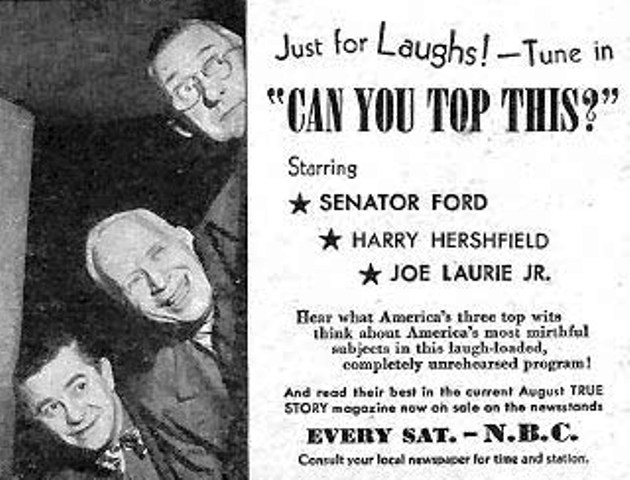
Joe Laurie, Jr., “The Pint-Sized Comedian” (bottom), came up with the idea to have a testimonial dinner for Tommy Lamb.
When people read about the dinner, they sent him gifts, including catnip, hand-knit sweaters and booties, dishes, and more. Pro boxer Edward Patrick “Mickey” Walker gave him a set of boxing gloves and New York artist James Montgomery Flagg sketched a portrait of him among all his fellow Lambs.
A month after the dinner, Mrs. Diana Belais, president of the New York Anti-vivisection Society, presented a silver medal to Tommy. The medal was accompanied by this inscription:
“Thomas Casanova Lamb crept into the Lambs’ club four years ago when he was an orphan and took up residence in the bar, fattening on the beer and free lunches until now he is a great, husky gray and white cat who is to receive our medal for his super-intelligence and devotion.”
Although Tommy was long since gone “to where all good cats go” when Joe Laurie published his vaudeville book in 1953, Laurie said he did leave a grandson who was even more talented than his grandpa cat.
This cat was trained by Willie, The Lambs’ long-time waiter, to sit up with a cigarette in his mouth while wearing glasses and holding a newspaper in his paws. The word was, when Tommy III (I don’t know his real name) was on the pool table, nobody was allowed to chase him off – the players simply had to shoot around him.
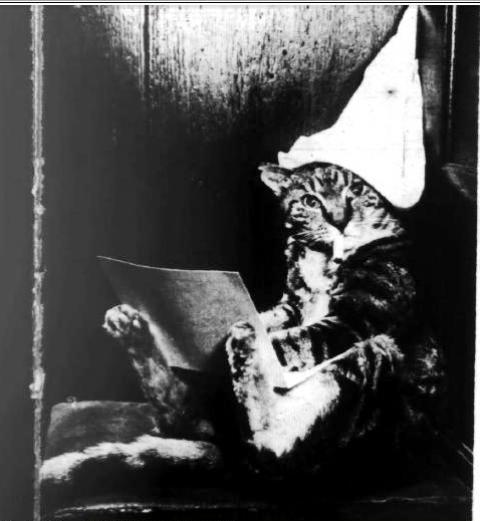
Tommy Lamb’s grandson was very well trained. Here, he strikes one of his favorite poses for the press.
Sounds to me as if Tommy’s grandson was a life member, too.




On behalf of The Lambs (www.The-Lambs.org), thanks! We love this!
I knew you would — it was a fun story to write! Does anyone know the name of Tommy’s “grandson”? Also wonder if there are any photos from this magnificent dinner honoring Tommy.
On behalf of The Lambs (www.The-Lambs.org), thanks! We love this!
I knew you would — it was a fun story to write! Does anyone know the name of Tommy’s “grandson”? Also wonder if there are any photos from this magnificent dinner honoring Tommy.
Theater animals sure were treated royally years ago. Billy and Tommy not so cute – but Tommy’s grandson is a winner.
Tommy was a boxer, so he had to be a tough-looking guy!
Theater animals sure were treated royally years ago. Billy and Tommy not so cute – but Tommy’s grandson is a winner.
Tommy was a boxer, so he had to be a tough-looking guy!